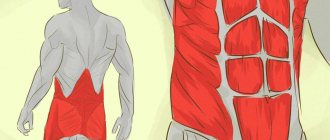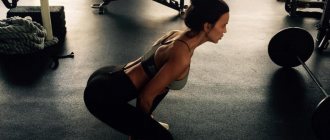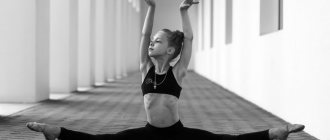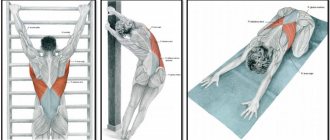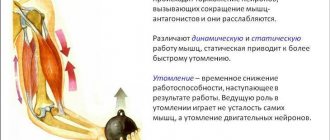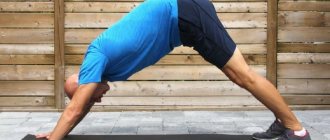A set of special exercises
Designed to develop flexibility of the back muscle group. All exercises are aimed at ensuring that performing a gymnastic bridge does not bring painful sensations, but is performed as easily and quickly as possible.
Exercise one
Lying on your stomach, arms extended upward. Trying to bend as much as possible, lift your legs and arms at the same time. Keep your knees straight. In each upper position they linger for 30-60 seconds.
Exercise two
Lying on your back, legs bent at the knee joints, arms extended along the body. The pelvis is raised to the maximum possible height, held in this position for about 5 seconds and smoothly lowered back onto the back.
Exercise three
Kneel down so that your legs are hip-width apart. The torso is slowly tilted back, bending at the lower back, and the hands touch the heels. In this case, you need to tilt your head back and arch your back.
Exercise four
Lie on your stomach, holding your ankles with your hands. While bending, they simultaneously raise their legs, chest and head. In the upper position they linger for several seconds.
Exercise five
Performed on a fitball. They lie on it with their backs, put their feet shoulder-width apart, raise their arms, and then try to touch them to the floor.
Exercise six
Performed from a prone position. Straight arms are placed at hip level. First, the back is bent back, and then, bending the legs at the knee joints and throwing back the head, touch the toes to the head. In the final position you need to stay for 30 seconds.
Exercise seven
At the end of the complex, a bridge is performed from a supine position. First, bend your arms and legs. Place your hands as close to your shoulders as possible, and your elbows point up. Then from this position they try to stand on the bridge. The legs and arms are straightened and the lower back is bent.
As soon as you feel that it is no longer possible to bend further, you need to stay in this position for at least two seconds. When the exercise ceases to cause difficulties, it is necessary to complicate it. To do this, the arms are pulled closer to the legs and then swung back and forth.
The given exercises must be performed daily. They will not only allow you to easily stand on the gymnastic bridge, but will also relieve problems with the spine. The complex can be performed by absolutely everyone, regardless of age.
A set of exercises to develop flexibility
This set of exercises will seem quite simple to you, but it is very effective, especially for people leading a sedentary lifestyle. Thanks to it, metabolism improves, all organs are saturated with oxygen, and the body becomes more flexible and plastic. It is best to practice in front of a mirror.
Exercises for flexibility of the cervical spine
- Stand straight, feet shoulder-width apart, move your shoulder blades back and stretch the back of your head towards the ceiling. Imagine that you are a rag doll being pulled up by strings. Feel the lengthening of your spine.
- Slowly tilt your head forward, hold the position for 30 seconds, return to the original position. Then slowly tilt your head to one side, then to the other, trying to touch your ear to your shoulder. Finally, turn your head over each shoulder and look behind you.
Exercises for flexibility of the thoracic spine
- Stand straight, stretch your arms to the sides. Take a breath and hug yourself tightly with your arms. As you exhale, again stretch your arms to the sides and squeeze your shoulder blades together. Repeat the complex 10 times. For many girls, this part of the spine is the weakest, which can lead to poor posture and back pain.
- Place your hands in a lock behind your back - one hand on top, the other on bottom. Try to grip as best as possible - not only with your fingers, but also with your palms. Change the position of your hands.
- Stand with your back to the back of a chair (window sill, bed, table), grab it with your hands. Squat down slowly until you feel a stretch.
- Lying on your stomach, place your hands on the floor and bend your chest as much as possible. Hold the position for half a minute. While remaining lying down, grab your feet with your hands (then your ankles), arch your back, and stay in this position for 30 seconds.
- Take the “bridge” position, stay in it for half a minute, gradually achieving full straightening of your arms and legs.
Exercises for flexibility of the lumbar spine
- Standing on the floor, place your feet shoulder-width apart and place your hands on your waist. Do 15 bends in each direction.
- Without changing your position, rotate your body in the lower back, first clockwise, then counterclockwise. Now clasp your hands at the back of your head and make a series of rotational movements in each direction.
- Kneel down, reach your arms back and grab your ankles or heels. Bend at the lumbar region for 30 seconds.
- Remaining on your knees, squat first to one side, then to the other. Do 15 reps on each side.
Exercises to develop flexibility in the pelvic region
- While standing, place your hands on your waist. Bring one leg bent at the knee forward. Do 10 rotations, first in one direction, then in the other. Repeat the exercise for the second leg.
- Kneel down and grab your ankles or heels with your hands. Bend your lower back and stretch your pelvis forward. Hold for 30 seconds.
- Sit on the floor, stretch one leg forward, bend the other at the knee and press your foot against the inner thigh of the other leg. Bend forward, trying to reach your feet with your hands and lay your chest on your leg. Hold the position for half a minute and repeat the same for the other leg.
- Now bend one leg and move it back so that your knee and inner thigh touch the floor. Stretch forward and stay in this position for 30 seconds. Switch legs.
- Remaining sitting on the floor, bend one leg and pull it up, trying to bring it behind your head. Repeat the exercise for the second leg.
Exercises to develop flexibility in the knee joint
- Standing on the floor with your legs fully straightened, bend over, trying to reach your palms to the floor, and press your head and chest to your legs. Pause for a minute.
- Now spread your legs shoulder-width apart, stretch first to one leg, then to the other.
- Make a lunge, while the leg that is behind should remain completely straight. Stretch forward until you feel a stretch in the back of your leg at the knee joint.
- Sit on the floor, straighten your legs. Stretch your hands towards your feet, trying to lie completely with your chest on your legs. Then spread your legs as wide as possible and bend over, trying to lie with your chest on the floor.
- Lying on your back, one leg extended and the other bent at the knee. Grab the ankle of your bent leg and pull it up. Then pull her towards you. Repeat the exercise for the second leg.
Wrist and ankle flexibility exercises
- Sit on the floor, stretch your legs, pull your toes towards you. Stay in this position for 30 seconds.
- Without changing your position, perform a series of rotational movements with your feet.
- Sit on your knees, lean on the outside of your hands. Place your hands so that your palms are facing you.
Performing a bridge from a standing position
You can move on to this exercise after you have completely completed and mastered the preparatory complex. It can be performed either against a wall bars or against a regular wall. The main thing is the availability of free space.
Stand with your back to a wall or wall, maintaining a distance of about 80 cm from its surface, with your feet shoulder-width apart. From this position, they begin to lean back until their fingers rest against the wall. To lower yourself, move your fingers along the slats or along the surface of the wall until the moment when your hands are on the floor and a full bridge is made.
The final position is held for several seconds and then returned to the original position. This should be done in the same way as lowering with the help of your fingers, moving them along the wall or slats, but already going up.
When performing a bridge with a wall has been brought to automaticity, you can begin doing the exercise on a gymnastics mat. At first, it is better to perform a bridge on the mat with a partner who will support your back for safety.
To do a bridge on the mat while standing, bend back, stay in the position for a few seconds, and then smoothly lower yourself onto the bridge. You also need to linger in the last position. To take the starting position, just push off the mat with your hands.
You should start making a bridge yourself only after you have gained complete confidence in your own abilities.
Office stretching
This stretch is for those who are very busy. All exercises can be performed directly in an office chair.
Everything must be done in order, moving from head to toe. First of all, you need to stretch the muscles of your neck and face. Give yourself free rein and start making faces and turning your head with pleasure. It is advisable that no one is nearby at this moment, since your colleagues may not share your desire to be healthy.
Warm up the neck muscles. Working at a computer puts you under a lot of stress. You should try to straighten your back as much as possible without getting up from your chair. Next, place your right hand on the top of your head and gently tilt your head to the right. Hold the position for 10-20 seconds, and then smoothly and slowly return your head to its original position. Repeat the same thing, changing your hand and side of your head. You need to do 5-8 repetitions on each side. Exercise accelerates blood through the veins and helps prevent salt deposition in the cervical spine.
Let's move on to the shoulder girdle and pectoral muscles:
1. First, we sit on the edge of the chair, stretch our arms forward, lock them together and spread our legs. 2. Exhaling, you need to smoothly round your back, lower your head and try to touch your stomach with your chin, and then lower your arms down without opening them. 3. Straighten up, raising your arms to the sides and placing your fingers behind your back in a lock. We bend, pull our arms back and chest forward.
The entire chain of steps must be repeated 5-6 times.
Now let’s relax our back using twists:
1. Sit well on a chair, spread your legs, and keep your back straight. 2. Grabbing the armrest and backrest with your hands, we turn the entire body to the right as far as possible. Keep your back straight, knees in front. Only the body should work. We fix the accepted position for 10-15 seconds. 3. Perform the exercise by turning the body to the left.
1. Sit on the edge of a chair, spread your legs as far as possible, trying to feel how the inner surfaces of your thighs are involved in the work. 2. We rest our palms on the pelvic bones and tilt the body forward. At the same time, you must keep your back straight, without lowering your head or sagging your neck. At the lowest point you need to linger for 20-25 seconds and then straighten up.
How to stand on the bridge correctly and gracefully
The effectiveness of the gymnastic bridge is given by the correct technique and beautiful execution. There are several common mistakes to avoid:
- There is no need to be afraid of losing your balance when walking onto the bridge using your back and shoulders. When performed correctly, only your hands should be involved.
- Quite often, many people do the exercise without transferring the weight of their own body to their arms, that is, through their back, without using their shoulders. As a result, the arms are too arched, and the bridge is unstable and looks unsightly.
The correct bridge is performed with the weight transferred to the hands. The angle between the hands and the floor should be straight. This can be achieved by pre-warming the shoulders. To do this, standing on the bridge, you need to rock back and forth, stretching the shoulder muscles.
Legs up pose
This exercise can be done both during the day and in the evening at any time when you want to relax or relieve fatigue, and before bed - it’s easier to fall asleep.
To perform the exercise, you need to lie as close to the wall as possible, being on a flat surface of the bed or a rug on the floor so that you feel comfortable.
Raise your feet and place them as close to the wall as possible so that they are at a 90 degree angle
. Your knees should be straight and your head should be on the floor or bed.
Shoulders and hips are at the same level. Relax your shoulders
, do not press them to your ears, and keep your hands loose at your sides, palms up or down.
If you feel tension in your neck, place a towel roll or small pillow under your head. Also, many people place a pillow or cushion under their lower back or buttocks.
. Find the position that is most comfortable for you.
Relax
. Just lie down and breathe deeply, stretching your inhalations and exhalations. You can check to see if there are any tightness or tension in your body and release them. Feel the weight lifting from your legs.
Stay in this position for 5 to 20 minutes
at your own discretion.
To come out of the pose, bring your knees to your chest, turn onto your right side and lie down, taking a few deep breaths. Using your legs and arms to push, stand up or, if you are doing this before bed, just go to bed.


